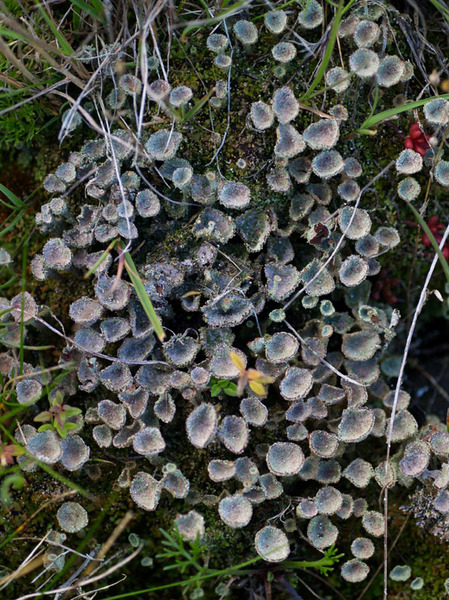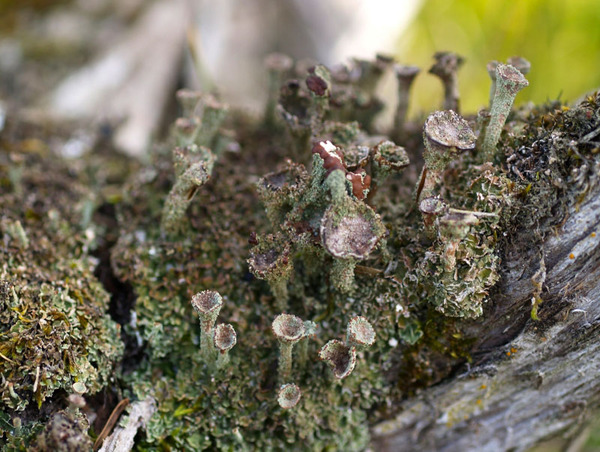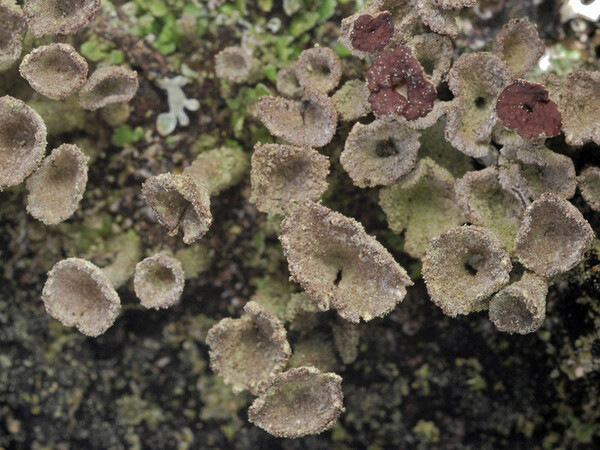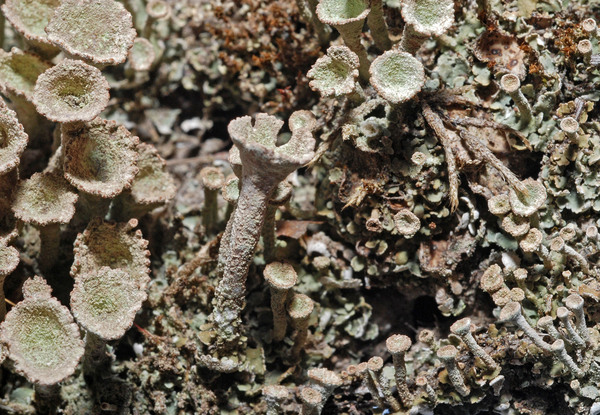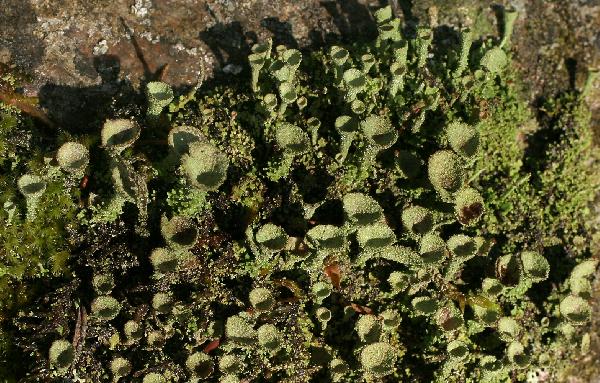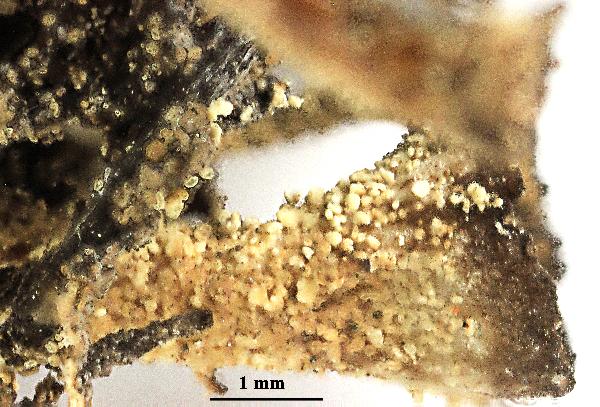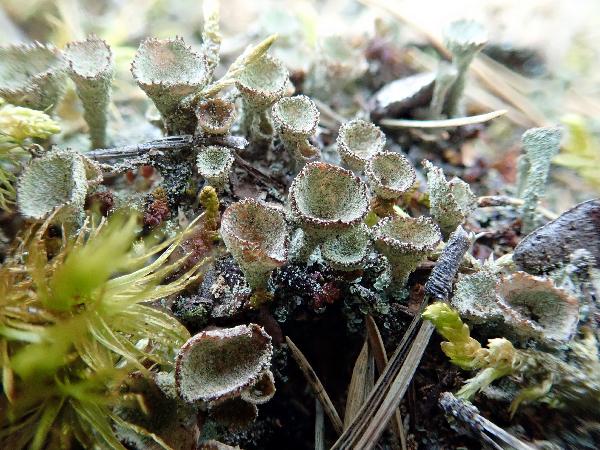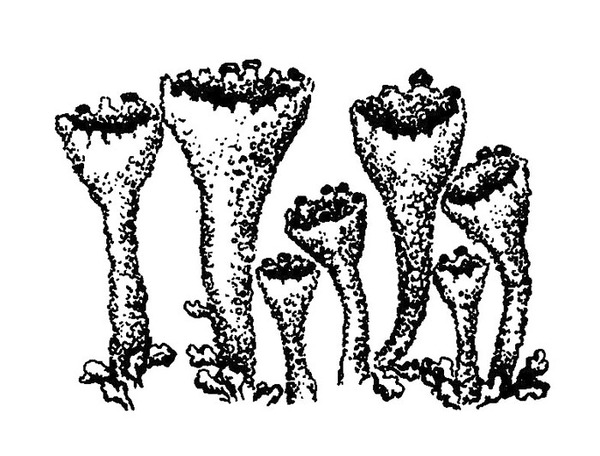Cladonia chlorophaea (Sommerf.) Spreng.
Syst. Veg., 4, 1: 273, 1827. Basionym: Cenomyce chlorophaea Flörke ex Sommerf. - Suppl. Fl. Lapp.: 130, 1826.
Synonyms: Cladonia costata Flörke; Cladonia pyxidata subsp. chlorophaea (Sommerf.) Arnold; Cladonia pyxidata var. chlorophaea (Sommerf.) Flörke
Distribution: N - Frl (Tretiach & Molaro 2007, Tomasi 2007), Ven (Ravera & al. 2022b), TAA (Nascimbene 2014, Nascimbene & al. 2014, 2022), Lomb (Stofer 2006, Gheza 2015, 2018, 2019, 2019b, Gheza & al. 2022, Ravera & al. 2023, Rapaccini & al. 2025), Piem (Gheza 2020, Gheza & Nascimbene 2024), VA, Emil (Fariselli & al. 2020), Lig (Gheza & al. 2020). C - Tosc (Brackel 2015, Gheza & al. 2020, Frati & Brunialti 2023), Laz, Abr (Brackel 2015, Gheza & al. 2021), Sar (Nöske 2000, Cossu 2013). S - Camp (Jatta 1909-1911), Cal (Stofer 2006), Si (Czezuga & al. 1994, Brackel 2008b).
Description: Primary thallus squamulose, persistent, the squamules small to middle-sized. 3-4(-6) mm long and almost as broad), incised to crenate, greyish-green above, white beneath, but darkening towards the base, sometimes with granular soredia along the margins. Podetia frequent, hollow inside, greyish-green, often somewhat browned, non melanotic at the base, esquamulose, 0.5-3(-4) cm tall, ecorticate or corticate only at the base, with broad (to 1.2 cm) cups gradually tapered to a short stalk, regular or proliferating marginally, granulose-sorediate above and inside the cups, the soredia 60-170 μm in diam., often mixed with corticate granules and microsquamules, the surface becoming denuded with age. Apothecia frequent, on the margin of the cups, brown, stipitate, convex, often arranged in up to 5 mm wide clusters. Asci 8-spored, clavate, thickened at apex, with a K/I+ blue tholus and a K/I+ strongly blue outer gelatinous sheath, Cladonia-type. Ascospores 1-celled, hyaline, ellipsoid. Pycnidia dark, semi-immersed in small teeth along the margins of cups, often constricted at base, with a colourless jelly. Conidia hyaline, curved. Photobiont chlorococcoid. Spot tests: K- or K+ yellowish slowly turning brown, C-, KC-, P+ red, UV-. Chemistry: substances of the fumarprotocetraric acid complex, often with quaesitic acid and unknown fatty acids.Note: this species belongs to a group of taxa containing only substances of the fumarprotocetraric acid complex. The main discriminating features are the presence of granular soredia on the outer and inner surfaces of the cups and the non-melanotic base of podetia. The discrimination towards C. pyxidata, C. fimbriata and other species of the complex is not always easy, and most records require re-confirmation.
Growth form: Fruticose
Substrata: bark, lignum, soil, terricolous mosses, and plant debris
Photobiont: green algae other than Trentepohlia
Reproductive strategy: mainly asexual, by soredia, or soredia-like structures (e.g. blastidia)
Commonnes-rarity: (info)
Alpine belt: rather common
Subalpine belt: rather common
Oromediterranean belt: rather common
Montane belt: very common
Submediterranean belt: very common
Padanian area: very rare
Humid submediterranean belt: very common
Humid mediterranean belt: rather rare
Dry mediterranean belt: rather common
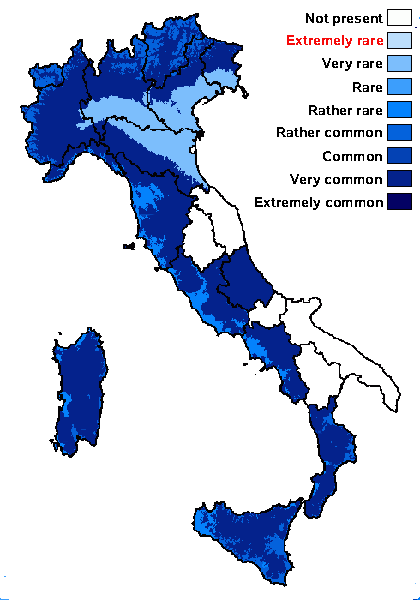
Predictive model
Herbarium samples
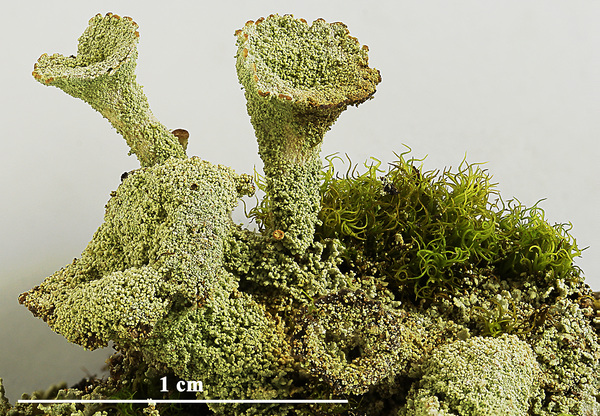

Felix Schumm – CC BY-SA 4.0
[18914], Frankreich, Vogesen, zwischen Colmar und Gerardmer, Col de la Schlucht, nahe Centre de ski de fond; 48.0622° N, 7.02068° E, 1140 m. Leg. F. Schumm 25.06.2013
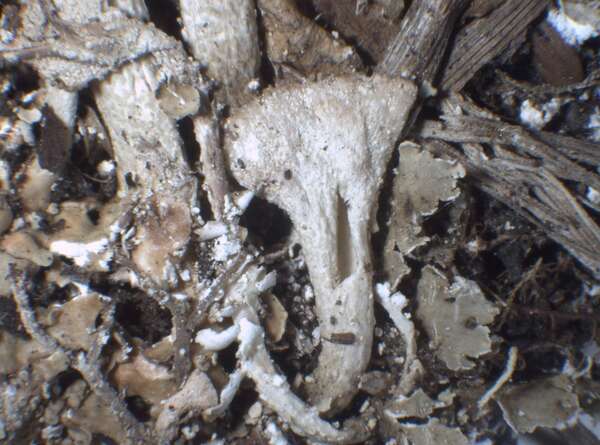

P.L. Nimis; Owner: Department of Life Sciences, University of Trieste
Herbarium: TSB (7080)
2003/03/06


P.L. Nimis; Owner: Department of Life Sciences, University of Trieste
Italy, Friuli Venezia Giulia, Udine, Ampezzo Carnico, 650 m
09.09.2016
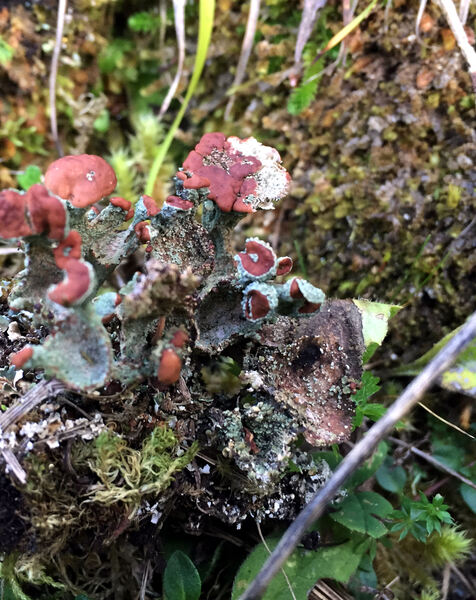

P.L. Nimis; Owner: Department of Life Sciences, University of Trieste
Italy, Friuli Venezia Giulia, Udine, Ampezzo Carnico, 650 m
09.09.2016


Felix Schumm – CC BY-SA 4.0
[339], Germany, Baden-Württemberg, Rems-Murr-Kreis, Stetten an der Rems, Überlandzentrale, an alten Stubben, TK: 7222. Leg. E. Putzler 15.03.1947, det. O. Klement


Felix Schumm – CC BY-SA 4.0
[339], Germany, Baden-Württemberg, Rems-Murr-Kreis, Stetten an der Rems, Überlandzentrale, an alten Stubben, TK: 7222. Leg. E. Putzler 15.03.1947, det. O. Klement
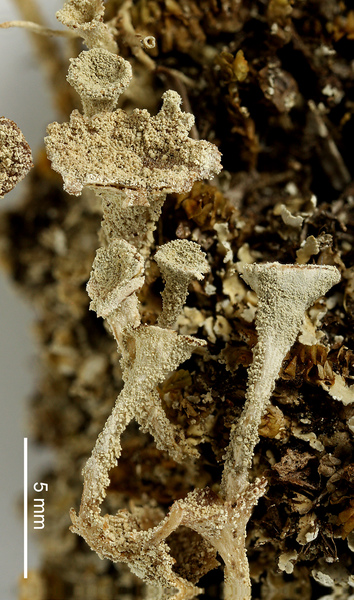

Felix Schumm – CC BY-SA 4.0
[16039], Portugal, Madeira, Rabacal, Lorbeerwald bei 25 Fontes, N 32°45.699, W 17°8.051, 1069 m. Leg. Schumm 12.04.2001, det. Aptroot 2010.
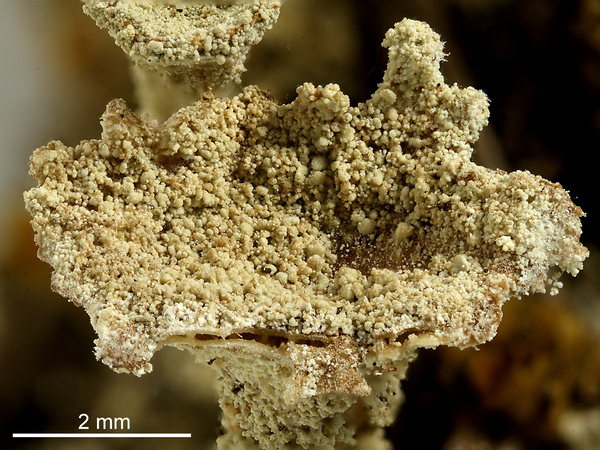

Felix Schumm – CC BY-SA 4.0
[16039], Portugal, Madeira, Rabacal, Lorbeerwald bei 25 Fontes, N 32°45.699, W 17°8.051, 1069 m. Leg. Schumm 12.04.2001, det. Aptroot 2010.
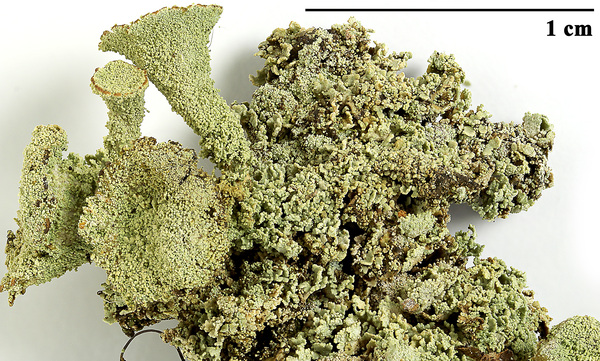

Felix Schumm – CC BY-SA 4.0
[18914], Frankreich, Vogesen, zwischen Colmar und Gerardmer, Col de la Schlucht, nahe Centre de ski de fond; 48.0622° N, 7.02068° E, 1140 m. Leg. F. Schumm 25.06.2013
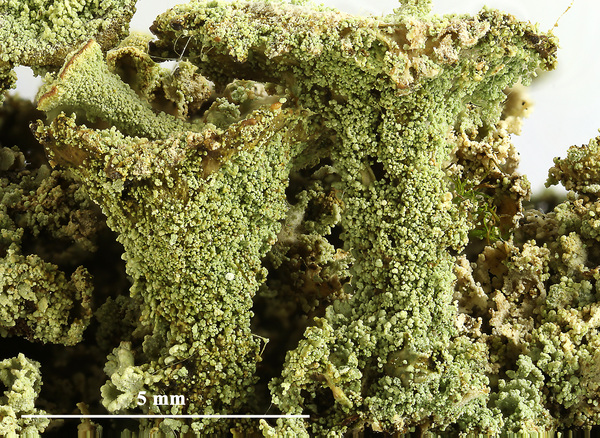

Felix Schumm – CC BY-SA 4.0
[18914], Frankreich, Vogesen, zwischen Colmar und Gerardmer, Col de la Schlucht, nahe Centre de ski de fond; 48.0622° N, 7.02068° E, 1140 m. Leg. F. Schumm 25.06.2013


Felix Schumm – CC BY-SA 4.0
[18914], Frankreich, Vogesen, zwischen Colmar und Gerardmer, Col de la Schlucht, nahe Centre de ski de fond; 48.0622° N, 7.02068° E, 1140 m. Leg. F. Schumm 25.06.2013
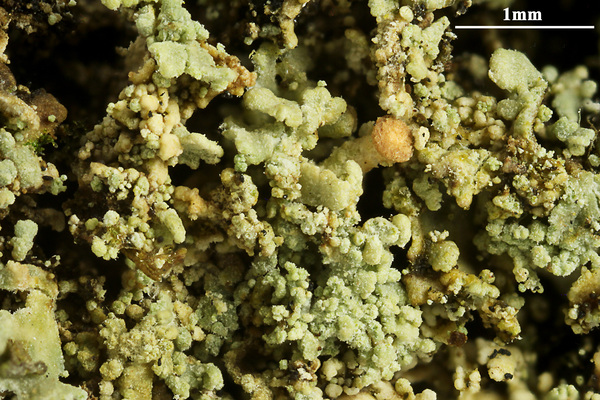

Felix Schumm – CC BY-SA 4.0
[18914], Frankreich, Vogesen, zwischen Colmar und Gerardmer, Col de la Schlucht, nahe Centre de ski de fond; 48.0622° N, 7.02068° E, 1140 m. Leg. F. Schumm 25.06.2013
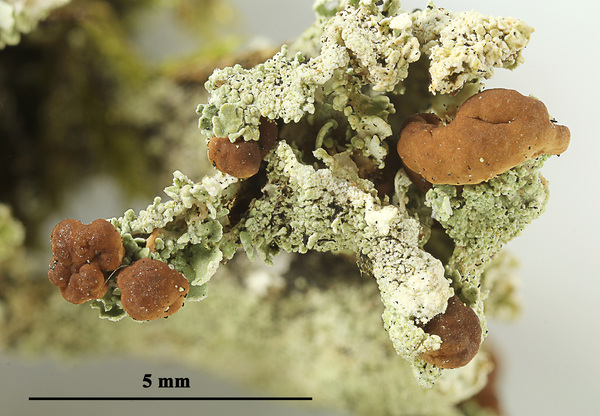

Felix Schumm – CC BY-SA 4.0
[19492], Germany, Schwarzwald, Kreis Freudenstadt, NW von Baiersbronn, ca. 2 km oberhalb Obertal. 48.54692° N, 8.27071° E, 720 m. Leg- F. Schumm, 6.9.2016, F. Schumm
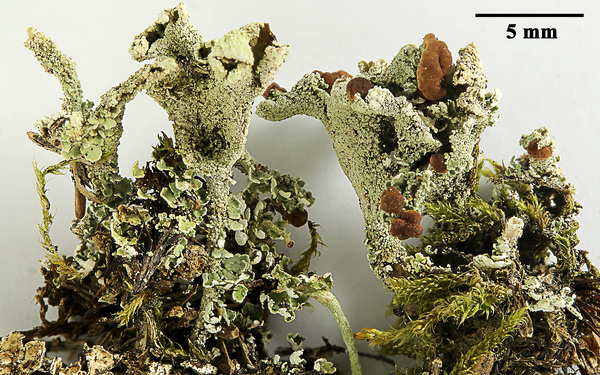

Felix Schumm – CC BY-SA 4.0
[19492], Germany, Schwarzwald, Kreis Freudenstadt, NW von Baiersbronn, ca. 2 km oberhalb Obertal. 48.54692° N, 8.27071° E, 720 m. Leg- F. Schumm, 6.9.2016, F. Schumm
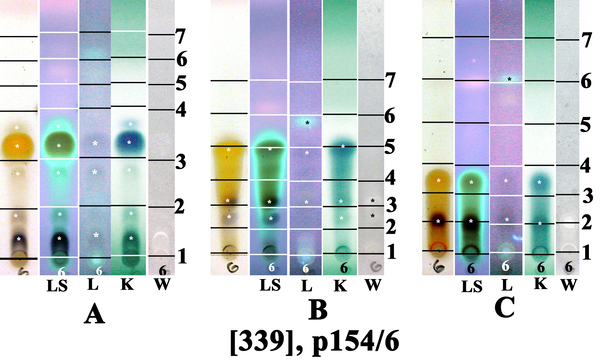

Felix Schumm – CC BY-SA 4.0
[339], Germany, Baden-Württemberg, Rems-Murr-Kreis, Stetten an der Rems, Überlandzentrale, an alten Stubben, TK: 7222. Leg. E. Putzler 15.03.1947, det. O. Klement,
von Diploschistes: le: lecanoric acid, di: diploschistesic acid; von Cladonia: f: fumarprotocetraric acid, p: protocetraric acid


Felix Schumm – CC BY-SA 4.0
[16039], Portugal, Madeira, Rabacal, Lorbeerwald bei 25 Fontes, N 32°45.699, W 17°8.051, 1069 m. Leg. Schumm 12.04.2001, det. Aptroot 2010.,
HPTLC in den Laufmitteln A, B’ und C nach Säurebehandlung bei Tageslicht und 366 nm UVLangwelle. 1: Start 4: Position von Norstictinsäure 7: Position von Atranorin pr: Protocetrarsäure fpr: Fumarprotocetrarsäure
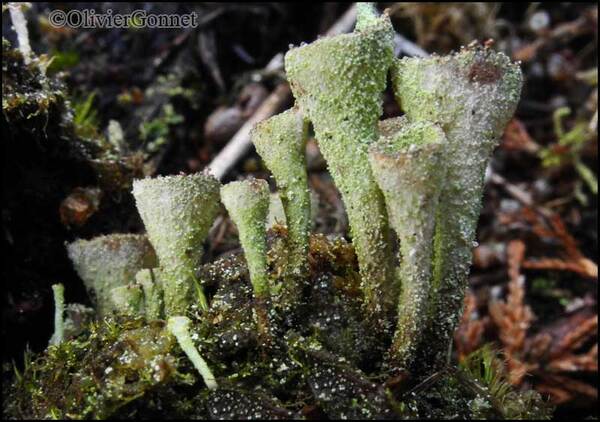
Courtesy: Olivier et Danièle Gonnet - Source: https://www.afl-lichenologie.fr/Photos_AFL/Photos_AFL_C/Textes_C2/Cladonia_chlorophaea.htm
France, session AFL en Normandie - 2012 - Orne
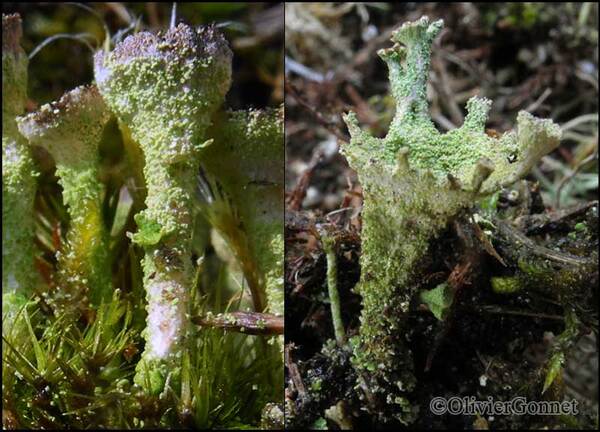
Courtesy: Olivier et Danièle Gonnet - Source: https://www.afl-lichenologie.fr/Photos_AFL/Photos_AFL_C/Textes_C2/Cladonia_chlorophaea.htm
France, session AFL en Normandie - 2012 - Orne
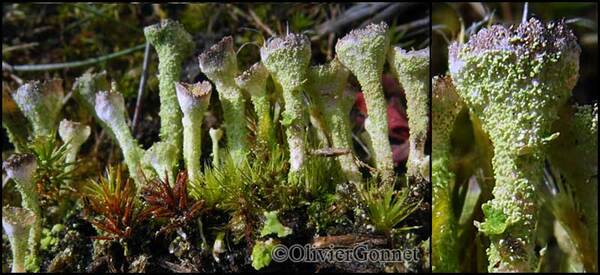
Courtesy: Olivier et Danièle Gonnet - Source: https://www.afl-lichenologie.fr/Photos_AFL/Photos_AFL_C/Textes_C2/Cladonia_chlorophaea.htm
France, session AFL en Normandie - 2012 - Orne
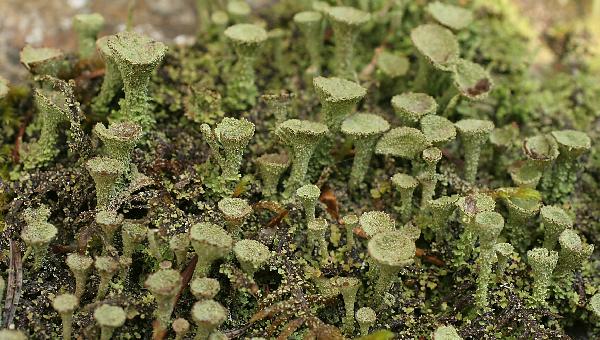
Ulrich Kirschbaum CC BY-SA 4.0 - Source: https://www.thm.de/lse/ulrich-kirschbaum/flechtenbilder
Central Europe: Germany.
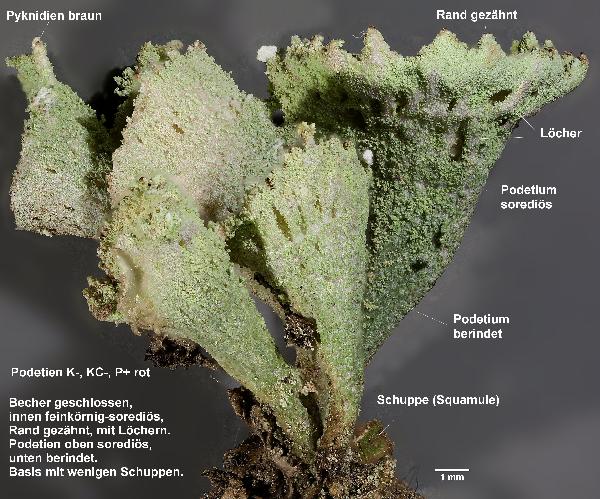
Ulrich Kirschbaum CC BY-SA 4.0 - Source: https://www.thm.de/lse/ulrich-kirschbaum/flechtenbilder
Central Europe; Germany: Hesse. Coll. Akina Wagner, ident. Kirschbaum.
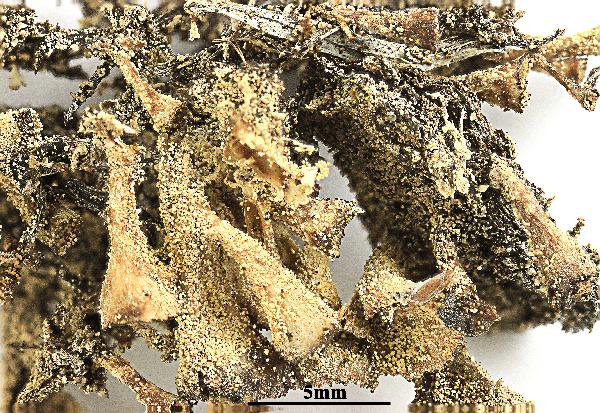

Felix Schumm - CC BY 4.0
[15154]. La Reunion, nordöstlich von Bourg-Murat, Col de Bellevue,
verbuschte Weidevegetation, nebelfeucht; 21,17797°S, 55,58010°E,
1617 m. Leg. F. Schumm & J.-P. Frahm, 09.09.2009, det. T. Ahti 2011.
Growth form: Fruticose
Substrata: bark, lignum, soil, terricolous mosses, and plant debris
Photobiont: green algae other than Trentepohlia
Reproductive strategy: mainly asexual, by soredia, or soredia-like structures (e.g. blastidia)
Commonnes-rarity: (info)
Alpine belt: rather common
Subalpine belt: rather common
Oromediterranean belt: rather common
Montane belt: very common
Submediterranean belt: very common
Padanian area: very rare
Humid submediterranean belt: very common
Humid mediterranean belt: rather rare
Dry mediterranean belt: rather common

Predictive model
| Herbarium samples |


Felix Schumm – CC BY-SA 4.0
[18914], Frankreich, Vogesen, zwischen Colmar und Gerardmer, Col de la Schlucht, nahe Centre de ski de fond; 48.0622° N, 7.02068° E, 1140 m. Leg. F. Schumm 25.06.2013


P.L. Nimis; Owner: Department of Life Sciences, University of Trieste
Herbarium: TSB (7080)
2003/03/06


P.L. Nimis; Owner: Department of Life Sciences, University of Trieste
Italy, Friuli Venezia Giulia, Udine, Ampezzo Carnico, 650 m
09.09.2016


P.L. Nimis; Owner: Department of Life Sciences, University of Trieste
Italy, Friuli Venezia Giulia, Udine, Ampezzo Carnico, 650 m
09.09.2016


Felix Schumm – CC BY-SA 4.0
[339], Germany, Baden-Württemberg, Rems-Murr-Kreis, Stetten an der Rems, Überlandzentrale, an alten Stubben, TK: 7222. Leg. E. Putzler 15.03.1947, det. O. Klement


Felix Schumm – CC BY-SA 4.0
[339], Germany, Baden-Württemberg, Rems-Murr-Kreis, Stetten an der Rems, Überlandzentrale, an alten Stubben, TK: 7222. Leg. E. Putzler 15.03.1947, det. O. Klement


Felix Schumm – CC BY-SA 4.0
[16039], Portugal, Madeira, Rabacal, Lorbeerwald bei 25 Fontes, N 32°45.699, W 17°8.051, 1069 m. Leg. Schumm 12.04.2001, det. Aptroot 2010.


Felix Schumm – CC BY-SA 4.0
[16039], Portugal, Madeira, Rabacal, Lorbeerwald bei 25 Fontes, N 32°45.699, W 17°8.051, 1069 m. Leg. Schumm 12.04.2001, det. Aptroot 2010.


Felix Schumm – CC BY-SA 4.0
[18914], Frankreich, Vogesen, zwischen Colmar und Gerardmer, Col de la Schlucht, nahe Centre de ski de fond; 48.0622° N, 7.02068° E, 1140 m. Leg. F. Schumm 25.06.2013


Felix Schumm – CC BY-SA 4.0
[18914], Frankreich, Vogesen, zwischen Colmar und Gerardmer, Col de la Schlucht, nahe Centre de ski de fond; 48.0622° N, 7.02068° E, 1140 m. Leg. F. Schumm 25.06.2013


Felix Schumm – CC BY-SA 4.0
[18914], Frankreich, Vogesen, zwischen Colmar und Gerardmer, Col de la Schlucht, nahe Centre de ski de fond; 48.0622° N, 7.02068° E, 1140 m. Leg. F. Schumm 25.06.2013


Felix Schumm – CC BY-SA 4.0
[18914], Frankreich, Vogesen, zwischen Colmar und Gerardmer, Col de la Schlucht, nahe Centre de ski de fond; 48.0622° N, 7.02068° E, 1140 m. Leg. F. Schumm 25.06.2013


Felix Schumm – CC BY-SA 4.0
[19492], Germany, Schwarzwald, Kreis Freudenstadt, NW von Baiersbronn, ca. 2 km oberhalb Obertal. 48.54692° N, 8.27071° E, 720 m. Leg- F. Schumm, 6.9.2016, F. Schumm


Felix Schumm – CC BY-SA 4.0
[19492], Germany, Schwarzwald, Kreis Freudenstadt, NW von Baiersbronn, ca. 2 km oberhalb Obertal. 48.54692° N, 8.27071° E, 720 m. Leg- F. Schumm, 6.9.2016, F. Schumm


Felix Schumm – CC BY-SA 4.0
[339], Germany, Baden-Württemberg, Rems-Murr-Kreis, Stetten an der Rems, Überlandzentrale, an alten Stubben, TK: 7222. Leg. E. Putzler 15.03.1947, det. O. Klement,
von Diploschistes: le: lecanoric acid, di: diploschistesic acid; von Cladonia: f: fumarprotocetraric acid, p: protocetraric acid


Felix Schumm – CC BY-SA 4.0
[16039], Portugal, Madeira, Rabacal, Lorbeerwald bei 25 Fontes, N 32°45.699, W 17°8.051, 1069 m. Leg. Schumm 12.04.2001, det. Aptroot 2010.,
HPTLC in den Laufmitteln A, B’ und C nach Säurebehandlung bei Tageslicht und 366 nm UVLangwelle. 1: Start 4: Position von Norstictinsäure 7: Position von Atranorin pr: Protocetrarsäure fpr: Fumarprotocetrarsäure

Courtesy: Olivier et Danièle Gonnet - Source: https://www.afl-lichenologie.fr/Photos_AFL/Photos_AFL_C/Textes_C2/Cladonia_chlorophaea.htm
France, session AFL en Normandie - 2012 - Orne

Courtesy: Olivier et Danièle Gonnet - Source: https://www.afl-lichenologie.fr/Photos_AFL/Photos_AFL_C/Textes_C2/Cladonia_chlorophaea.htm
France, session AFL en Normandie - 2012 - Orne

Courtesy: Olivier et Danièle Gonnet - Source: https://www.afl-lichenologie.fr/Photos_AFL/Photos_AFL_C/Textes_C2/Cladonia_chlorophaea.htm
France, session AFL en Normandie - 2012 - Orne

Ulrich Kirschbaum CC BY-SA 4.0 - Source: https://www.thm.de/lse/ulrich-kirschbaum/flechtenbilder
Central Europe: Germany.

Ulrich Kirschbaum CC BY-SA 4.0 - Source: https://www.thm.de/lse/ulrich-kirschbaum/flechtenbilder
Central Europe; Germany: Hesse. Coll. Akina Wagner, ident. Kirschbaum.


 INDEX FUNGORUM
INDEX FUNGORUM
 GBIF
GBIF
 DOLICHENS
DOLICHENS
